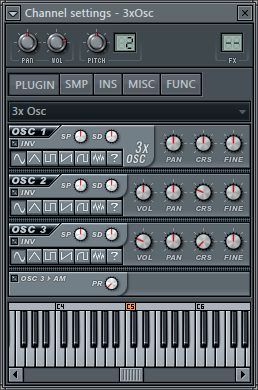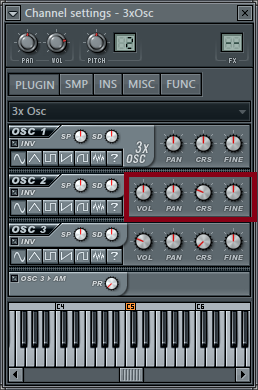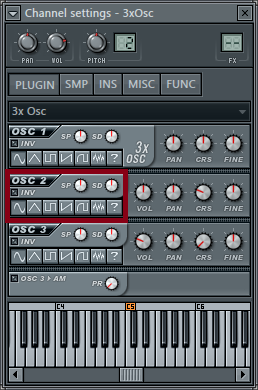Understanding synths: The principles of 3xOsc
As computers and technological machines have decreased in price and increased in quality, their prominence has pervaded every section of human lives. And with the universal popularity of music, its incorporation of digitalization is enormous and ever-expanding.
Modern pop songs rarely lack a virtual instrument called an electronic synthesizer. Synthesizers are like programmable keyboards, honing limitless customizability due to their homes in computers. Some are free, some are simple, some more disorienting than the names of women’s nail polish. This guide will explore the basic properties of electronic synthesizers and how those properties function in a simple synth called 3xOsc. If you’re not interested in electronic sound design, this tutorial can perhaps build appreciation in a reader as they learn the intricate language of computerized music.
Revision on 3.24.15: If you don’t have Fruity Loops Studio, you won’t have 3xOsc, and this article will destroy you. To ease confusion, you can download the demo of FL Studio at this place. Mac users, I’m sorry: This program is exclusive to Windows!
Let’s go!
3xOsc is a product of Image-Line, a company famous for their music-production program (usually called DAWs, or Digital Audio Workstations) Fruity Loops Studio, and their interesting selection of synths. 3xOsc is one of their simplest, and can be a fantastic learning tool for a new music producer.
3xOsc’s name is an abbreviation for “three oscillators.” An oscillator is a type of electronic circuit that, in music, can produce different types of sound waves. 3xOsc has three of them, hence the name, labeled OSC 1, OSC 2 and OSC 3 on the instrument’s left corner.
Each oscillator produces a noise, which a user can alter with digital modification present in the synth. Since there are three oscillators in 3xOsc, the user can “design” three different oscillators that will play simultaneously. 3xOsc is a simple synth, but its triad of oscillators grants it thousands of different sounds.
Now having the knowledge of oscillators and what they do, you’re ready to learn the basic principles of sound design!
See the red outline in 3xOsc? Four knobs control the volume (VOL), pan (PAN), coarse (CRS), and fine tuning (FINE) of OSC 2. Four identical knobs are registered to OSC 3, and all but a volume knob modify OSC 1.
These knobs are super easy to understand. The volume knob controls volume, however blatant that sounds.
The PAN knob dictates how much of the sound OSC 2 generates will travel into the left and right speakers. Headphones will display a left and right variation more clearly than dual speakers, and a singular speaker (technically known as a mono speaker) won’t have any difference, because it has only one channel.
“Panning” volume all the way to the left will only play OSC 2 in the left speaker. Panning volume to the right will fade loudness in the left speaker, and mixes of such will apply a low level of volume on one side, and a higher level on the other.
The CRS knob modifies semitones. If OSC 2 is playing a C, like a piano, and the CRS is shifted up by one semitone, OSC 2 will play a C# instead. A pitch increase of one semitone will play the next note up. In the diagram, the CRS knob is tilted downward to -12 semitones, which is one octave below a note at 0 semitones. So, if OSC 1, with its CRS at 0 semitones, played a G note, OSC 2 would play a G note one octave down, emulating the same sound but at a lower pitch.
The FINE knob works like the CRS knob, except it is one hundred times more precise. The FINE knob warps pitch in a measure of cents. There are a hundred cents in a semitone, so raising OSC 2’s FINE knob to +100 cents would change a C to a C#, exactly like its CRS knob will change at the same rate when adjusted upward by one degree.
You’ll probably need half an hour and a healthy bit of tinkering before understanding the VOL, PAN, CRS and FINE knobs. That’s alright! The process of sound design is with horrifying complexity. Relax, be patient with yourself and have fun. Intermediate sound design is up next.
Remember oscillators, and their productions of sound waves? Variations of those sounds are called waveforms. The most basic, “default” type of waveform is the sine wave. It’s the parabolic line (it looks like a skewed, curvy “2”) selected for every oscillator in this diagram. There’s a ton of math involved in sound waves, and I’m barely passing Algebra II, so I won’t bother with that.
Sine waves sound basic. That’s as simple as I can tell it. They feel basic: a simple, lifeless tone with as much emotion as a metal gate. There’ll be a link to a C note played in every type of wave 3xOsc offers after this to demonstrate.
The order of sound waves in 3xOsc is
- Sine
- Triangle
- Square
- Saw, or sawtooth
- Sine-square hybrid
- Noise
- Custom
The custom slot labeled with a question mark opens a menu for a file selection, which allows use of wave shapes the user has created or downloaded. This guide won’t branch into those.
After the sine is the triangle. They have whispers of the dull sine wave, but are rougher and seem more akin to “Gameboy” style sounds.
Square waves are huge and abrasive, losing more of the sine-like tones and becoming gruff. Saw waves aren’t as obnoxious as squares and bear a nasal overtone.
The next waveform is a hybrid of the sine and square. It keeps some nasality from the saw wave, but likens to someone saying “Ah.”
Noise waveforms are static, white noise: the sound a television exfoliates when the screen is a mess of black and white fuzz. These are great for percussion and sound effects.
Here they are in action. Be wary they don’t sound so pretty when a single note’s played. So the pattern repeats after the single notes play, with a somewhat more beautiful arpeggiation.
SoundCloud.com/glassandrubber/3xosc_is_fun
If you listened to more than half of that, you might have heard strange differences. The demonstration sounds different halfway through because the stereo phase and stereo detune are shaping the sound.
Stereo phase is “phasing” between two channels (which is stereo. Mono is one channel, stereo is two) and belongs to knob labeled SP. Stereo phasing creates a chorus-like, lopsided effect upon the oscillator.
Stereo detune (the SD knob) is changing the pitch of the oscillator through the stereo, which also provides a ghostly feel. The detune is measured in cents, like the FINE knob.
Intermediate sound design, section two
You’ve progressed so far! Don’t forget to break often and experiment. If it sounds terrible, that’s good. You’re learning!
The next, and possibly most crucial part of 3xOsc (and any other synth) is the envelope editor. You can access this by clicking the INS (instrument) tab (boxed in blue in the diagram). This will open the VOL (volume) tab, which portrays a visual representation of the auditory pattern of 3xOsc. That’s boxed in red.
Don’t worry about the adjustment knobs and buttons below the VOL tab, starting at the TB button and downward. This guide won’t review those… yet.
The “envelope” of a synthesizer is the amount of time it will reach its full volume, and the amount of time it will require to stop. Consider the envelope to be a two-dimensional plane, with “volume level” on the Y-Axis and time on the X.
There are six factors that modify a synth’s envelope.
- Delay, which is how long a synth will wait until it produces any noise. This is 3xOsc’s DEL knob.
- Attack, which dictates how quickly a synth will rise in volume to its maximum level. This is 3xOsc’s ATT knob.
- Hold, which measures the length of time a synth’s sound will remain at its maximum level. It is the HOLD knob.
- Decay, or the DEC knob. Decay is the regression, or decay, in the volume of the synth.
- Sustain, compiled in the SUS knob, which modifies decay. If the sustain is set to maximum, a note will play eternally until the user manually stops it. If there’s no sustain, the note will immediately begin to fade when the amount of time the Hold knob set depletes, according to decay time. This can cut decay time short, skipping the noise to the REL knob.
- Release, which is the inverse of attack. It decides how long a note will keep playing after the user stops playing it, fading out in volume. That’s the last knob, titled REL.
The default envelope for 3xOsc is shown in the picture. One can see it has no delay, a small amount of attack, a bit of hold time and a quick delay the sustain knob is clipping to a notable amount of release. If you listened to the auditory demonstration of 3xOsc’s alternating waveforms, however, the sound began and stopped instantly, with no variation in between it. Why? The envelope editor wasn’t on, keeping 3xOsc at the immediate envelope in the sound.
When a user begins to edit the envelope, a graphic of a red light will appear by the envelope tab. That signifies the envelopes activation, and the synth will begin registering changes to it! Comprehending this is agonizing. Try altering one adjustment before any others. Soon, you’ll be able to create pianic notes with reverberating decays, orchestral swells with looming attacks, and eccentric, experimental leads with a mash of envelopal modifications.
Last step (Before we actually begin)
Upon finishing this guide, you’ve inhaled over fifteen-hundred words about 3xOsc’s simplest mechanisms — the next guide will uncover what it hasn’t here, and begin teaching information on effects and automation clips used in the song and instructional sound!
Below is a song I created with only 3xOscs to demonstrate what it can do (at least, what a lonesome fifteen-year-old kid can make it do). No effects, drums or other synthesizers have been added, but I did use the noise waveform for some percussion. I hope it’s helpful!
https://soundcloud.com/glassandrubber/3xosc-sample-song
Thanks for reading. Return to Crimsonnews.org soon to see this article’s next release!










FlaviusFire • Nov 19, 2018 at 4:05 am
This was super helpful! Now I’m gonna go read the second part. 😊
Daniel • Sep 18, 2018 at 8:13 am
3 years later and by far the most relevant guide I have come across on Oscillators. Many thanks.
Szwe • Jul 20, 2018 at 5:13 am
Hey man I loved your stuff thanks. Do you have more stuff on Mid side processing. Vocal processing.parallel compression?
Crystal • Sep 4, 2016 at 4:48 pm
Wow Micah when you don’t make one for Mac users so this is useless for me 🙁
nmsk • Nov 8, 2016 at 11:45 am
well if you read this tutorial you will understand what an oscillator is and how it works. you don’t need 3osc for it. and get a windows pc!! ^^
Ryan Gonzalez • Jun 27, 2016 at 4:53 pm
This guide was amazing! I’ve been struggling to grasp how synths work, and this helped a LOT.
James • Mar 21, 2016 at 2:56 am
Where is the next par5 just the sort of tutorial I was looking for.
Micah Summers • Apr 7, 2016 at 2:49 pm
Hey James! The next installment is right here: https://crimsonnews.org/1985/entertainment/understanding-synths-part-two/
Sorry for my late response, I didn’t see your comment until now 🙁